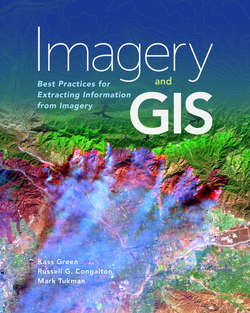Читать книгу Imagery and GIS - Kass Green - Страница 81
На сайте Литреса книга снята с продажи.
USGS EROS
ОглавлениеThe USGS EROS Center has one of the largest archives of moderate- and low-spatial-resolution imagery because they operate the US National Satellite Land Remote Sensing Archive, which includes the global Landsat archives as well as those for Advanced Very High Resolution Radiometer (AVHRR), Advanced Spaceborne Thermal Emission and Reflection Radiometer (ASTER), and other satellite systems. They also distribute the ESA Sentinel-2 imagery. Moderate- and low-spatial-resolution imagery available from EROS includes:
All Landsat imagery from 1972 to the present. The archive distributes more than 7,000 terabytes of Landsat imagery annually. Starting with Landsat 1 (launched in 1972) with four bands (G, R, 2 IR) at 80-m spatial resolution, the Landsat constellation of satellites has evolved to the Landsat 8 system (launched in 2013) with 10 bands at 15-m (panchromatic); 30-m (visible, near-infrared, and short-wave infrared); and 100-m (thermal) spatial resolution. No other remote sensing system provides a 40+ year continuous record of global observations. Landsat 9 is currently under construction and will be identical to Landsat 8 with a planned launch date in the early 2020s.
Figure 4.4. Comparison of the spectral resolutions of Landsats 7 and 8, Moderate Resolution Imaging Spectroradiometer (MODIS), and Sentinel-2. Source: USGS
ESA Sentinel-2 imagery. Sentinel-2A was launched in June 2015 with 13 bands in the visible (10-m resolution), near-infrared (10 to 20-m resolution), and short-wave infrared bands (20 to 60-m resolution). The spectral resolution is very similar to Landsat’s (figure 4.4) An identical satellite, Sentinel-2B launched in March of 2017. In a partnership with ESA, EROS distributes Sentinel-2 level 1C imagery.
AVHRR imagery from 1979 to the present at a 1-km spatial resolution. AVHRR 1.1-km imagery is captured worldwide twice every day and has been collected by NOAA’s polar-orbiting satellites from 1979 to the present.
Multispectral data over the United States acquired by SPOT-4 and -5 satellites. This dataset of licensed commercial imagery is available only to US civil government agencies (2010 to 2013).
The SPOT Controlled Image Base is an orthorectified product derived from panchromatic images with a 10-m ground sample distance. Coverage is limited to portions of the United States, Europe, Middle East, Southeast Asia, North and South Korea, Central America, western Russia, and other smaller areas around the world (1986 to 1993).
ASTER is one of a number of instruments on board the Terra platform, which was launched in December 1999. ASTER provides 14 spectral bands with 15- to 90-meter resolutions depending on the bands. ASTER does not acquire data continuously; its sensors are activated only to collect specific scenes upon request. The instrument consists of three separate telescopes; each provides a different spectral range and resolution. The visible and near-infrared sensor provides four bands at a 15-meter resolution. The short-wave infrared sensor provides six bands at a 30-meter resolution. The thermal infrared sensor provides five bands at a 90-meter resolution. The swath width for all sensors is 60 kilometers.
Table 4.4. Sources of currently operating panchromatic and multispectral moderate-spatial-resolution systems. (esriurl.com/IGT43 for current version.)
The USGS and NASA have collaborated on the creation of the Global Land Surveys datasets. Each of these collections was created using the primary Landsat sensor in use at the time, which were processed for either 5-year or 10-year periods with best available images.
WELD data. Global monthly and annual 30-meter global composites generated from contemporaneous Landsat 7 Enhanced Thematic Mapper Plus (ETM+) and Landsat 5 Thematic Mapper (TM) data for all non-Antarctic land surfaces are available for 3-year periods. Continental US and Alaska WELD data are weekly, monthly, seasonal, and annual 30-meter continental US and Alaska composites generated from Landsat 7 ETM+ data available for 10 years (2003 to 2012). Products are available through an interactive web interface or as hierarchical data format tiles from a direct download site.
MODIS is one of a number of instruments carried on the Terra platform, which was launched in December 1999. MODIS provides continuous global coverage every one to two days and collects data from 36 spectral bands (band designations). Bands 1 and 2 have a resolution of 250 meters. Bands 3 through 7 have a resolution of 500 meters. The remaining bands, 8 through 36, have a resolution of 1000 meters. The swath width for MODIS is 2,330 kilometers.
